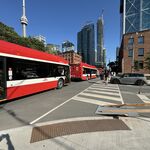As I already said
two posts back: Population size is an inappropriate measure for comparing the network lengths of road or rail infrastructure, but it definitely influences the pace at which that infrastructure can be built, especially for highly capital-intensive mega-projects like HSR. For instance, the California HSR is expected to cost (at least)
$68 billion, which represents only 0.4% of US GDP, but 3.8% of Canadian GDP. Similarly, the three options for implementing real HSR on the US Northeast Corridor are expected to cost
between $64 and $308, which represents between 0.4% and 1.8% of US GDP, but 3.6%-17.3% of Canadian GDP, while the $21.3 billion estimated construction costs for the E-300 Q-W scenario in the Ecotrain study translate to 1.2% of Canadian GDP, but only 0.12% of US GDP. Does anyone here seriously want to make the argument that a Canadian project with the capital cost of a few billion $$$ is as easy to finance through public budgets as an equally expensive project would be in the US...?





